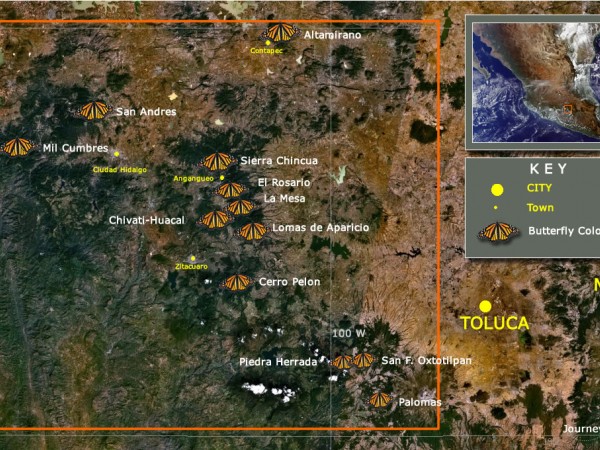Waiting at Cerro Pelon
October 30, 2018
Dear Friends,
We’re getting ready for the arrival of the monarchs on Cerro Pelon. My sisters-in-law are amping up their production of coronas, which they sell to our neighbors for the massive redecoration of the local cemetery on Day of the Dead. We’re also growing sempasuchil to adorn the graves. Newly arrived monarchs love to nectar on these marigolds.
Butterfly guide Anayeli Moreno and I have started hiking every morning to get in shape for the trip up to the colony. Even though we encourage the taking of horses up the mountain--horse rental is an important support for the local economy--some folks are either allergic, deathly afraid or think that riding horses is cruel. We want to be ready to walk the 800 m. ascent. Ana’s dad Melquiades, a retired CEPANAF forest ranger, has been leading our morning jaunts, showing us short cuts and teaching us idiosyncratic local names for places in the forest.
Happily, the forest we’re walking through is in better shape after this off season than it has been in previous years. You may have seen my plea for help in June 2017, when Cerro Pelon’s forest rangers were indefinitely pulled from the job. Their absence facilitated an illegal logging free for all in the sanctuary’s core protected area. If you signed our petition, thank you: it worked. The three rangers were returned last July and they and their employers CEPANAF are now collaborating with the Biosphere Reserve on forest protection. And since then, we’ve more than doubled paid presence in the forest with the Butterflies & Their People Cerro Pelon Arborist Project.
Last October we were able to use a grant from the Monarch Butterfly Fund to hire three additional Reserve residents to patrol the forest. Members of the International Butterfly Breeders Association visited in January and helped out with a high-quality camera, walkie talkies, new boots and other goodies. Then in April, a highly motivated group of JM Butterfly B&B guests started a Go Fund Me campaign that raised additional funds for the project in short order, which allowed us to hire a fourth arborist and continue to pay his predecessors once the MBF grant ended.
One thing the arborists have been doing is documenting bird life on Cerro Pelon. We have at least 68 species, including bumblebee hummingbirds, red warblers, golden browed warblers, russet nightingales and mountain trogans. More recently, the arborists started working on making trails safer for people and horses in preparation for the arrival of butterfly visitors.
They also pick up garbage on the mountain—taking down an average of 5-7 costales (a large burlap-like bag) every week with plastic bottles and bags. More than half of it comes from reforestation projects from years past. The arborists have asked me to ask those of you who donate to reforestation projects to please include picking up after yourself as part of these projects’ requirements.
Reforestation is a centerpiece of conservation efforts in Mexico. But planting trees only gives local people a few days of work a year. And without regular work, people turn to illegal logging, thus fueling the need for more reforestation. While tree nursery owners win, the monarchs and their neighbors (along with the rest of humanity) lose.
Being consistently employed has already made a difference in the arborists’ lives. Jose Carmen from Ejido Nicolas Romero added a floor to his house. Oswaldo of Comunidad Indigena Nicolas Romero invested in a flock of sheep. Francisco of Macheros, an elementary school graduate, enrolled his oldest daughter in college. And Leonel, also of Comunidad Indigena Nicolas Romero, broke ground on a new house after only six months of a steady paycheck.
More importantly, the arborists’ presence has made a difference to the forest. When the forest was abandoned last summer, the rangers came back to find some 80 trees down in the heart of the monarchs’ roosting area. In contrast, there was no logging in Cerro Pelon’s core protected area until last month, when illegal loggers waited until nightfall to take twelve trees. Twelve trees is still too many, and someday we would love to be able to hire even more arborists from the marginalized communities that produce these loggers.
We have the pleasure of meeting so many committed monarch enthusiasts through our B&B and butterfly tour business. I am constantly struck by the amount of passion and energy expended in the US and Canada on monarch conservation—where people are raising monarchs, tagging them, making reports, growing milkweed, and otherwise restoring habitat in the monarchs’ summer breeding grounds. But all these efforts will be for naught if we don’t make sure that the monarchs have a mature and intact forest home from November to March. Which is why I’d like to issue a heartfelt thank you to each and every one of our supporters who have helped make this conservation necessity a reality in our sanctuary.
Saludos desde Macheros,
Ellen Sharp
Co-owner, JM Butterfly B&B
Director, Butterflies & Their People, AC

